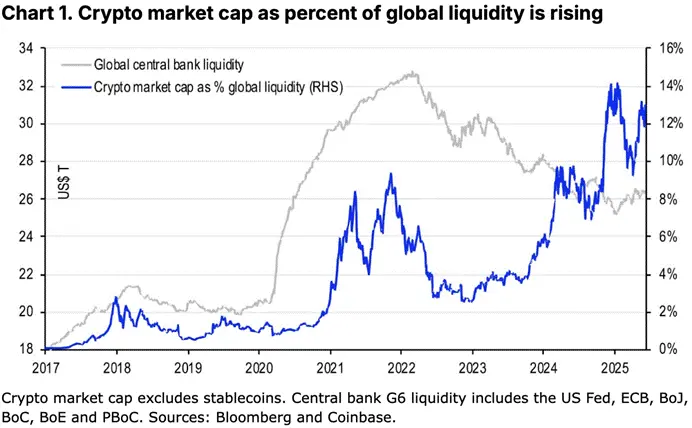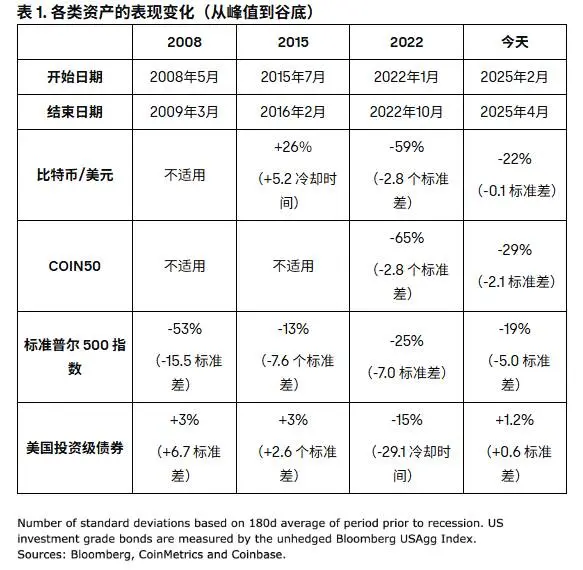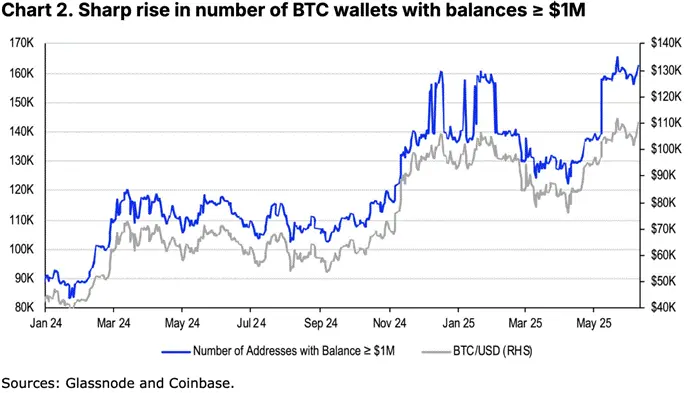Original Title: Monthly Outlook: Three Themes for 2H25
Original Author: David Duong, CFA - Global Head of Research
Original Translation: forest, ChainCatcher
This article is compiled from Coinbase's latest monthly outlook research report. The report indicates that the cryptocurrency market outlook for the second half of 2025 is optimistic, benefiting from better-than-expected economic growth, accelerated corporate entry, and improved regulatory environment. Although leveraged holdings pose certain systemic risks, the short-term impact is limited; meanwhile, legislation on stablecoins and market structure reforms are advancing rapidly.
The following content is a compilation and organization of the report's key points.
Key Insights
We hold a constructive view on the cryptocurrency market for the second half of 2025, primarily based on several key factors: an optimistic outlook for U.S. economic growth, potential interest rate cuts by the Federal Reserve, increased adoption of cryptocurrencies by corporate finance departments, and clearer U.S. regulatory policies. Although there are still some potential risks, such as the possibility of a further steepening of the U.S. Treasury yield curve and passive selling pressure on listed cryptocurrency investment tools, we believe these risks are manageable in the short term.
We believe there are three key themes currently worth paying attention to in the cryptocurrency market. First, the macroeconomic outlook is more optimistic than previously expected. The threat of recession has diminished, and the U.S. economy shows stronger signs of growth. While there is still a possibility of economic slowdown, the likelihood of asset prices significantly retreating to 2024 levels under current conditions is low. Second, despite the market's cautious attitude towards potential systemic risks in the medium to long term, corporate finance departments' adoption of crypto assets is becoming an important demand driver. Third, regulatory frameworks regarding stablecoins and the cryptocurrency market structure are advancing, which could have profound implications for the U.S. cryptocurrency landscape.
Despite certain risks in the market, we believe the upward trend of Bitcoin is likely to continue. However, the performance of altcoins is more likely to be influenced by their respective unique factors. For example, the U.S. Securities and Exchange Commission (SEC) is currently reviewing multiple cryptocurrency-related ETF applications, covering physical purchase and redemption mechanisms, the inclusion of staking features, multi-asset fund allocations, and ETF products targeting single altcoins. Relevant decisions are expected to be made gradually before the end of 2025, and these proposals and their final outcomes could have far-reaching effects on the cryptocurrency market landscape.
Positive Outlook for 2H 2025
We remain constructive about the market outlook for 2025. A few months ago, we suggested that the cryptocurrency market would hit bottom in the first half of 2025 and reach historical highs in the second half. Although Bitcoin has rebounded in late May, we believe this assessment still holds. In other words, from a trend perspective, the cryptocurrency market still has room for further growth in the next 3 to 6 months. In our view, the macro-level disruptions caused by tariffs have largely been digested. Looking ahead, as the U.S. government gradually shifts towards a more market-friendly policy stance and is expected to push through new fiscal legislation before the end of summer, overall market risk appetite is likely to improve.

However, a major risk to our view is that if government spending bills are passed, it could lead to a steeper U.S. Treasury yield curve, particularly in the 10 to 30-year maturity range. In fact, due to market concerns over the continued expansion of the U.S. fiscal deficit, the yield on 30-year Treasury bonds rose to 5.15% in May, the highest level in nearly two decades. This trend could lead to a tightening of financial conditions beyond market expectations, raising financing costs for businesses and consumers, thereby weakening economic growth momentum, which is one of the key factors supporting our optimistic market outlook. If long-term interest rates rise too quickly, we believe it could trigger volatility in the stock and credit markets, especially as investors begin to question whether the U.S. can maintain high deficit levels without severe consequences.
This situation would challenge the current mainstream narrative of "front-loading fiscal stimulus" and could prompt the market to reassess risk assets before long-term fiscal risks are fully realized, particularly if economic data or Federal Reserve policies fail to meet market growth expectations. On the other hand, we believe this scenario would enhance the prospects for value-storing assets like gold and Bitcoin, while the appeal of altcoins may diminish, as Bitcoin continues to benefit from the decline of the dollar's dominance.
Overall, we believe the trends in the cryptocurrency market for the second half of 2025 will revolve around the following three core themes:
- A more optimistic macro outlook for the second half of 2025, especially regarding expectations for U.S. economic growth
- The adoption of cryptocurrencies by corporate finance departments as an important demand driver, but investors may be concerned about potential systemic risks
- Reduced uncertainty regarding U.S. cryptocurrency regulation, but what will the future regulatory path look like?
Theme One: The Shadow of Recession is Gradually Fading
Trade disruptions at the beginning of 2025 once raised market concerns about the possibility of the U.S. economy entering a technical recession, especially as economic activity showed a quarter-over-quarter annualized decline of 0.2% in the first quarter of 2025. (At that time, headlines from media outlets like The Economist and The Wall Street Journal included "Trump's Trade War Threatens Global Economic Recession" and "Trump's Tariffs Could Trigger a U.S. Recession.") A technical recession refers to two consecutive quarters of negative growth in real GDP.
However, we still held a positive outlook for the second half of 2025 because we believed (and still believe) that the severity of the economic recession is key. While a technical recession may weaken investor confidence, it may not necessarily evolve into severe market disruptions unless the negative macroeconomic trends worsen further. In fact, the last true recession occurred in 2008 (when the U.S. stock market fell by 53%), while the recessions in 2015 and 2022 were relatively mild (see Table 1). Additionally, the Atlanta Federal Reserve's GDPNow model recently saw a significant increase in its forecast, rising from about 1.0% quarter-over-quarter growth in early May to 3.8% (seasonally adjusted) by June 5, reflecting a substantial shift in existing economic data.
Therefore, we believe that the worst-case scenario this year may be an economic slowdown or mild recession—if not completely avoiding recession—rather than falling into a severe recession or stagflation. In the context of an economic slowdown, market shocks may be relatively mild, manifesting more in specific industries rather than a broad decline across all asset classes. However, considering the rise in liquidity indicators such as the U.S. M2 money supply and global central bank balance sheets, we judge that these conditions are unlikely to lead to asset prices retreating to 2024 levels, which means the upward trend of Bitcoin may continue. Furthermore, the impact of tariffs may have already peaked, and even if investors remain cautious before July 9 (the deadline for most countries' reciprocal tariffs, with China set for August 12), the market may gradually adapt and enter a new normal.

Theme Two: Expansion of Corporate Crypto Holdings: The Rise of Clone Corporations
Currently, approximately 228 publicly traded companies globally hold a total of about 820,000 Bitcoins on their balance sheets. However, according to data from Galaxy Digital, only about 20 of these companies, along with another 8 that hold cryptocurrencies like Ethereum (ETH), Solana (SOL), and Ripple (XRP), have adopted the leveraged financing model pioneered by Strategy (formerly MicroStrategy). In our view, many of these companies have emerged in recent months, driven primarily by the new cryptocurrency accounting standards that will officially take effect on December 15, 2024. Prior to this, the Financial Accounting Standards Board (FASB) only allowed companies to account for cryptocurrencies as intangible assets under U.S. Generally Accepted Accounting Principles (GAAP), resulting in impairment losses. However, in December 2023, the FASB updated the relevant regulations, allowing companies to disclose their digital assets at fair market value.
In simple terms, the previous FASB guidelines largely hindered many companies from adopting cryptocurrencies because the old rules only allowed companies to record losses on crypto assets, while profits could not be recognized until the assets were sold, leading to potential gains not being reflected. The new FASB guidelines improve the accuracy of financial statements by more clearly reflecting the financial status of crypto assets and significantly simplify the accounting processes that many CFOs and auditors found challenging.
While this explains why more companies have disclosed their cryptocurrency holdings on their balance sheets this year, an increasingly evident trend is that more publicly traded companies are making "accumulation of crypto assets" a core part of their business. In other words, early adopters like Strategy and Tesla initially incorporated Bitcoin as an investment tool into their asset allocation based on their main business. In contrast, these emerging companies have set the accumulation of Bitcoin or other crypto assets as their primary goal from the outset. They finance their acquisitions of crypto assets through issuing stocks and debt (often convertible bonds), and many companies are trading at prices above their net assets.

The rise of publicly traded companies (PTCV) with cryptocurrencies as core assets has significant implications for the market, potentially driving demand for crypto assets while also introducing systemic risks to the crypto ecosystem. In our view, systemic risks mainly include two aspects: (1) forced selling pressure, and (2) opportunistic selling.
Forced Selling Pressure. The risk of forced selling arises from many PTCVs issuing convertible bonds to raise low-cost funds for purchasing various crypto assets. This structure allows bondholders to profit when the company's stock price rises, which is often correlated with the appreciation of the crypto assets they hold. If things do not go as expected, the company must repay the debt, and investors can at least recover their principal. To repay the debt, these PTCVs may be forced to sell their crypto assets unless they can successfully refinance, potentially leading to losses. Therefore, the market is concerned that if multiple PTCVs face repayment pressure simultaneously, there could be concentrated, irrational selling, triggering market liquidation and leading to a widespread decline in the entire crypto market.
Opportunistic Selling. The second risk is more insidious, as this structure may undermine investor confidence in the crypto ecosystem. For example, if one or more PTCVs suddenly sell a portion of their crypto assets, even if just for routine cash flow management or operational needs, it could trigger market concerns about price declines, leading to sudden price drops and market liquidations. In other words, once prices start to fall, these companies may perceive that exit channels are narrowing, prompting other holders to follow suit and sell, thereby causing market instability before the actual debt repayment issues become apparent.

However, overall, we believe that the downward pressure from the aforementioned two risks is unlikely to replicate the severe consequences caused by some past failed crypto projects. First, based on our assessment of the outstanding debts of nine related companies, most of the debts will not mature until the end of 2029 or early 2030, meaning that forced selling pressure in the short term is not prominent. (The first major maturing debt is Strategy's $3 billion convertible bond, which will mature in December 2029 and can be redeemed early in December 2026. See Chart 3 for details.) Furthermore, as long as the loan-to-value (LTV) ratio remains within a reasonable range, we believe that larger companies are likely to secure refinancing channels, allowing them to manage potential pressures without liquidating their reserve assets.
Of course, as debts gradually mature or more companies adopt similar strategies, our assessment may change, depending on the overall level of risk appetite and the length of repayment terms. In fact, there is no uniform standard for financing methods among PTCVs, which makes tracking their capital structures relatively complex. However, it is evident that Strategy's pioneering attempts have attracted other corporate executives interested in crypto assets, who may further explore whether such investment strategies are suitable for their companies. Overall, the market has not yet reached saturation, and the trend of corporate accumulation of crypto assets is expected to continue developing in the second half of 2025.
Theme Three: Opening a New Regulatory Path
In the first half of 2025, the U.S. regulatory landscape underwent unprecedented significant changes, laying the groundwork for digital asset policy to enter its most transformative phase to date. This change is in stark contrast to the previous administration's "enforcement over regulation" model. We believe that the second half of 2025 is likely to redefine the U.S. position as a global center for crypto assets, a trend supported by the White House's decisive policy shift in favor of the crypto industry and Congress's urgent efforts to establish a comprehensive regulatory framework for digital assets.
We believe that, with strong bipartisan support, stablecoin legislation is most likely to become the first significant crypto-related bill passed in the U.S. Congress. Both chambers of Congress have shown positive momentum, with the House advancing the STABLE Act and the Senate pushing the GENIUS Act, which complement each other in content. The Senate could potentially pass the GENIUS Act as early as next week, after which it will be sent to the House for consideration. Both bills set reserve requirements and anti-money laundering compliance standards for stablecoin issuers while also providing consumer protection and priority repayment terms for holders.
The two main differences between these bills focus on the regulatory approach to non-U.S. stablecoin issuers and the scale threshold for federal regulation. Congressional negotiators will coordinate on these differences in the coming months. Government officials have expressed confidence in submitting a unified bill to President Trump for signing before Congress adjourns on August 4, 2025. This could be an important step in advancing the crypto market structure legislation.
The crypto market structure legislation may become one of the most significant long-term developments this year, especially following the introduction of the 2025 Digital Asset Market Clarity Act (CLARITY Act) by the U.S. House Financial Services Committee on May 29. This bill aims to clarify the division of responsibilities between the Commodity Futures Trading Commission (CFTC) and the Securities and Exchange Commission (SEC) in the regulation of digital assets, specifically by classifying relevant assets as "digital commodities" or "investment contract assets."
This bill is further developed based on last year's Financial Innovation and Technology for the 21st Century Act (FIT21) passed by the House, but it also has some key differences. Most importantly, the current legislative draft requires the CFTC and SEC to jointly define core terms such as "digital commodities" and to fill regulatory gaps through subsequent rulemaking, meaning that the specific boundaries of regulatory authority may continue to evolve. While we believe this bill aims to lay the groundwork for future negotiations between the two chambers, it is important to note that negotiations surrounding market structure may be much more complex compared to those related to stablecoins.
ETF Approval Timeline. In addition, the SEC is facing a complex environment for cryptocurrency ETF applications in 2025, with approximately 80 proposals pending review, covering physical purchase/redemption mechanisms, staking features, index funds, and single-name altcoin ETFs:
- Several ETF issuers (such as Bitwise, Franklin Templeton, Grayscale, Hashdex) have submitted applications for multi-asset funds intended to track broad cryptocurrency indices. Many of these funds have weights of up to 90% in BTC and ETH, and the SEC already has a regulatory framework for crypto index ETFs, so a decision could be made as early as July 2.
- Proposals regarding physical purchase/redemption mechanisms are currently in the formal review stage by the SEC. Introducing this mechanism would not only help align ETF market prices with net asset values (NAV) but could also narrow the bid-ask spread of ETF shares. We believe the SEC may make a decision before July 2025, but it is also possible that it could be postponed until October 2025.
- For ETF proposals that include staking features, the SEC must make a ruling before October. It is reported that there are still internal doubts within the SEC about whether certain fund structures meet the definition of "investment companies." However, Bloomberg Intelligence believes that, considering the custom basket provisions and transparency standards in Rule 6c-11, the SEC may be forced to act sooner.
- Finally, there are several single-name altcoin ETF applications, most of which have a statutory review deadline of October. We expect the SEC to take the full review time to process these proposals.
Conclusion
We hold a constructive outlook for the cryptocurrency market in the third quarter of 2025, primarily supported by the following factors: a relatively optimistic outlook for U.S. economic growth, interest rate cuts by the Federal Reserve, increased corporate adoption of crypto assets, and greater transparency in U.S. regulatory policies. Although risks such as a steepening yield curve and potential passive selling pressure from listed crypto asset companies still exist, we believe these are manageable in the short term. That said, while we remain confident in the upward trend of Bitcoin, we believe that only a few altcoins with specific favorable factors are likely to perform well.
免责声明:本文章仅代表作者个人观点,不代表本平台的立场和观点。本文章仅供信息分享,不构成对任何人的任何投资建议。用户与作者之间的任何争议,与本平台无关。如网页中刊载的文章或图片涉及侵权,请提供相关的权利证明和身份证明发送邮件到support@aicoin.com,本平台相关工作人员将会进行核查。




